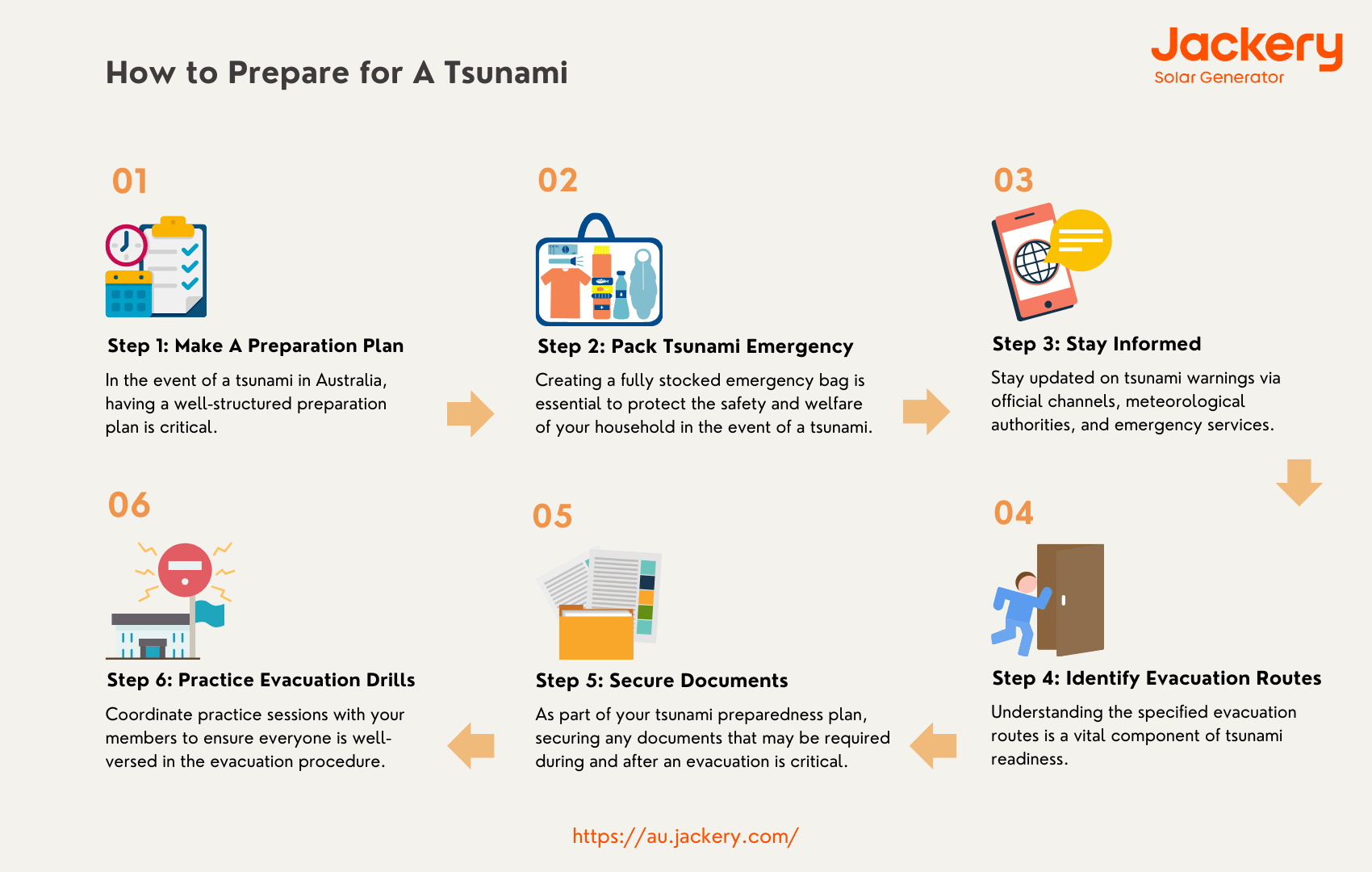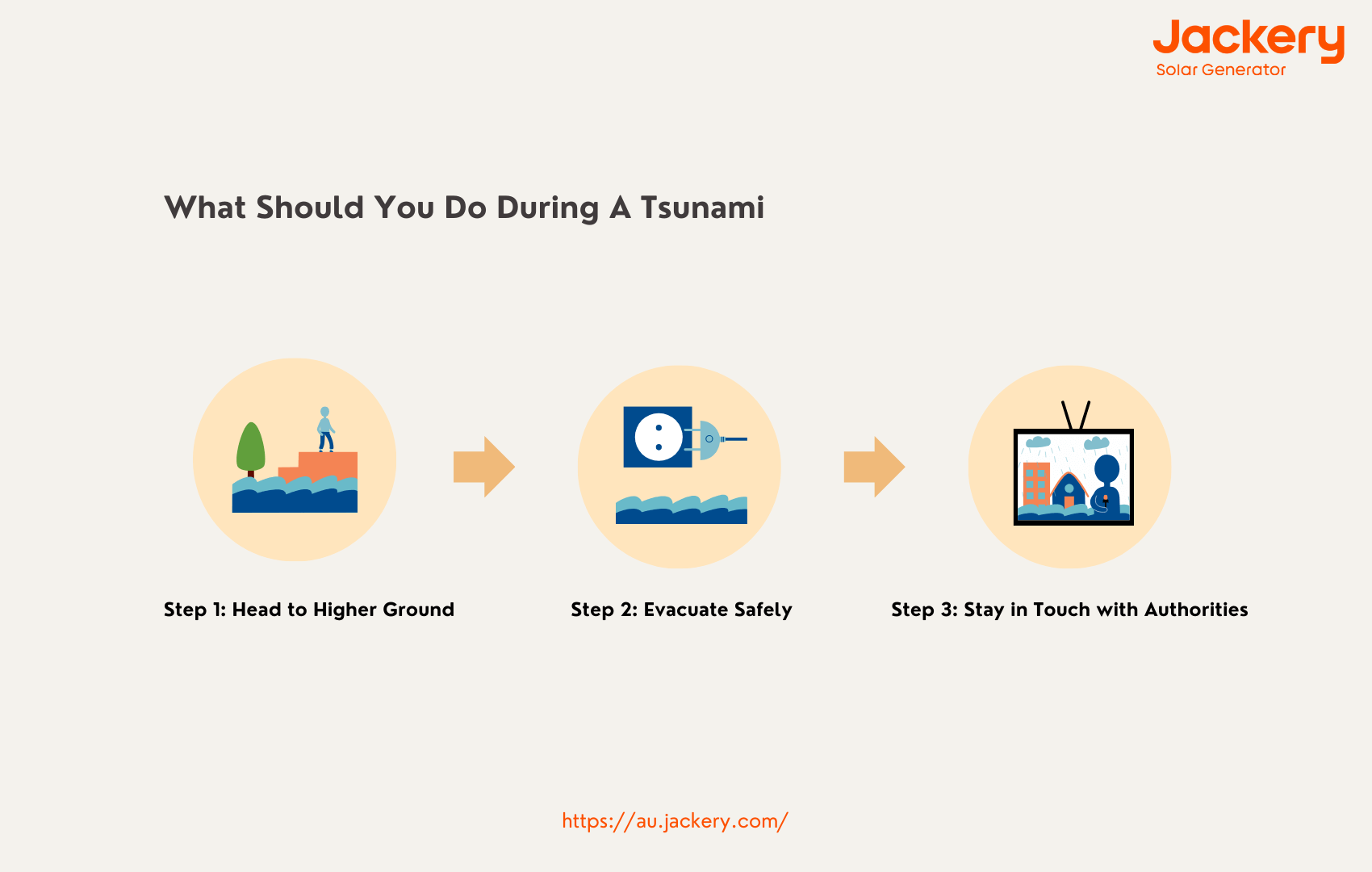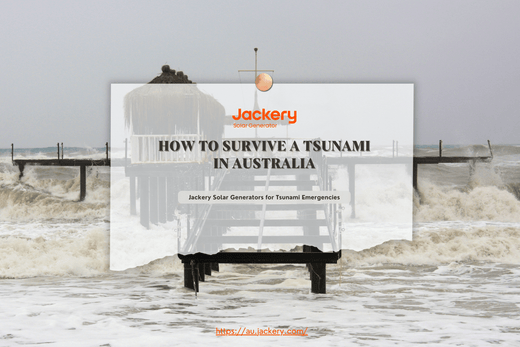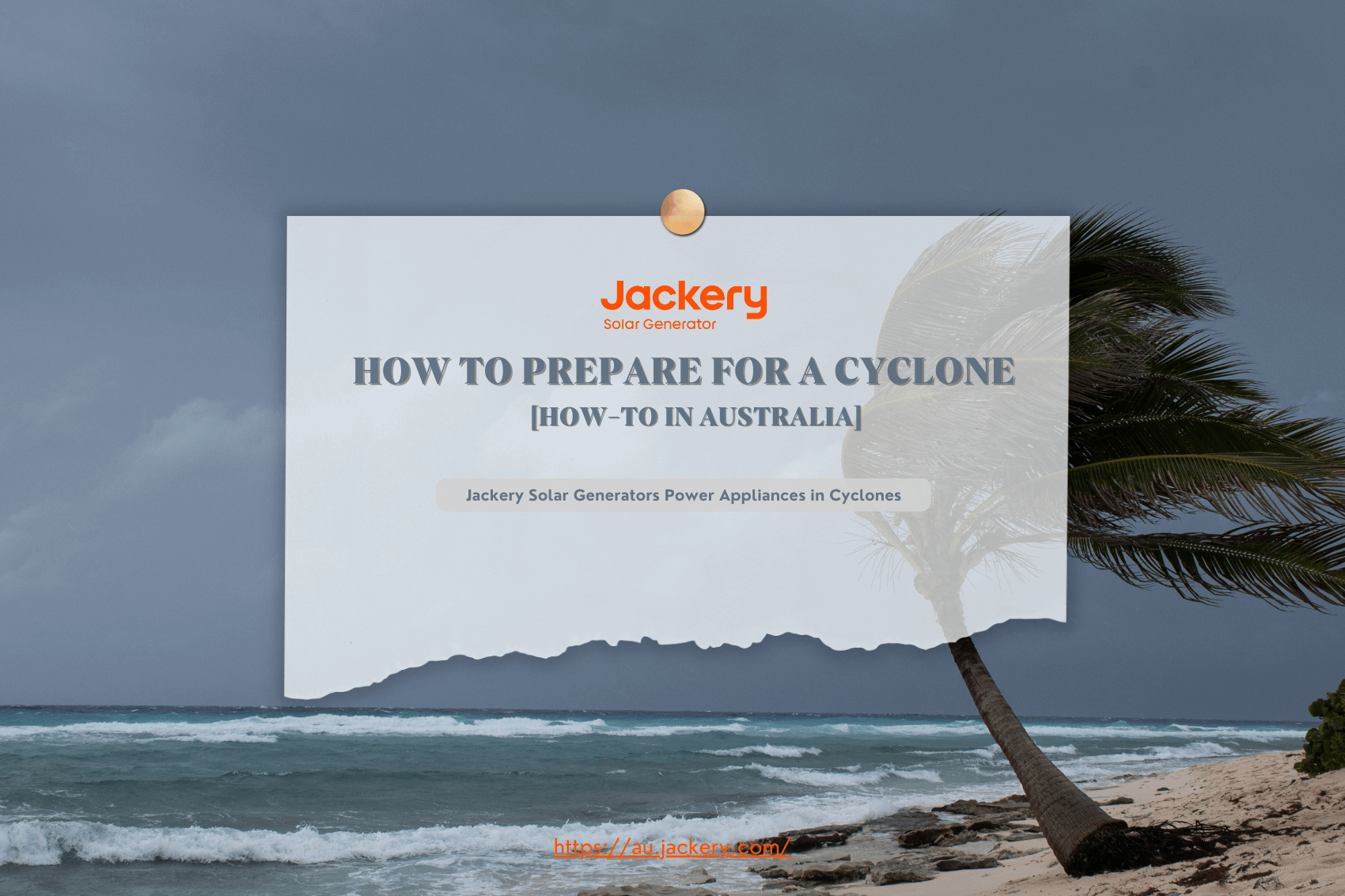|
Key Takeaways: |
|
• A tsunami in Australia is a sequence of ocean waves characterised by long wavelengths and tremendous energy, usually triggered by undersea seismic events like earthquakes or volcanic eruptions in the nearby waters. • There are six steps to prepare for a tsunami in Australia, including making a preparation plan, packing an emergency kit, staying informed with authorities and others, identifying evacuation routes, securing necessary documents, and practising evacuation drills. • We highly recommend Jackery Solar Generator 600 Plus and 300 Plus to power your essential devices, such as the radio, flashlight, phone, refrigerator, and more, during a tsunami. • During a tsunami, you must find a better place to stay, evacuate safely with your families, and contact local authorities. • After the tsunami, checking your property, yourself & others, and food safety is best. Besides, you should clean up and restore the stuff. |
What Is A Tsunami in Australia?
A tsunami is a sequence of ocean waves characterised by long wavelengths and great energy, usually triggered by undersea seismic events like earthquakes or volcanic eruptions. Tsunamis can traverse entire ocean basins, and when they reach the coast, they turn into solid water surges, unlike typical ocean waves.
Tsunamis pose distinctive issues because of their abrupt occurrence and capacity for extensive devastation along shorelines. Subsequent waves may pose extended dangers to coastal towns, making the initial wave less significant. Tsunamis can cause flooding, property destruction, and, in extreme situations, loss of life.
To prepare for tsunamis, one must comprehend the dangers, know early warning systems, and have evacuation strategies in place. Coastal areas should have dependable instruments and tactics like raised shelters and communication systems to ensure an efficient and quick response in case of a tsunami alert. Enhanced awareness and readiness are crucial in reducing the destructive impact of tsunamis on susceptible coastal regions.
A tsunami in Australia is a sequence of ocean waves characterised by long wavelengths and tremendous energy, usually triggered by undersea seismic events like earthquakes or volcanic eruptions in the nearby waters. Tsunamis are infrequent occurrences along the Australian coast but provide a substantial danger, particularly to coastal regions.
|
Tsunami Classification |
||
|
Tsunami magnitude (m) |
Tsunami height (H) |
Damage |
|
-1 |
50 cm |
None |
|
0 |
1 m |
Very little damage |
|
1 |
2 m |
Coastal and shipping damage |
|
2 |
4 m~6 m |
Damage and lives lost in certain land areas |
|
3 |
10 m~20 m |
Considerable damage to the coastal areas |
|
4 |
30 m |
Massive damage to the coastal areas |
(Data Source: Research Gate)
How to Prepare for A Tsunami in Australia?
Residents in tsunami-prone areas must comprehend the enduring effects of these occurrences and take long-term precautions. Beyond emergency evacuation, communities should create comprehensive plans for long-term consequences like prolonged displacement, infrastructure damage, and disruption of critical services. Increased knowledge and preparation for tsunamis' long-term effects help construct resilient coastal communities. The following are the detailed instructions for surviving a tsunami in Australia.

Step 1: Make A Preparation Plan
In the event of a tsunami in Australia, having a well-structured preparation plan is critical. Begin by learning about your area's local tsunami risk and evacuation routes. Familiarise yourself with the warning indications of a tsunami, such as intense and prolonged ground shaking or abnormal ocean activity. Create a family emergency communication plan that includes how you'll remain in touch and where you'll meet if separated during the evacuation.
Find elevated and safe areas where you can immediately seek safety. Collaborate with your neighbours and community members to improve overall preparedness. As part of your evacuation plan, save critical documents, including identification, insurance policies, and medical information, in a waterproof container. Establishing a comprehensive preparation plan enables you and your community to respond to the particular challenges posed by a tsunami properly.
Download Tsunami Preparation Plan PDF>>
There are more preparation plans and actions that you can check:
- How to prepare for a bushfire in Australia
- How to prepare for a cyclone in Australia
- How to prepare for Sydney storm
Step 2: Pack Tsunami Emergency
Creating a fully stocked emergency bag is essential to protect the safety and welfare of your household in the event of a tsunami. Ensure you have non-perishable food products, sufficient water, a first aid kit, and necessary medications. Consider possible evacuation situations, and prepare warm clothing, blankets, and durable footwear. Moreover, remember to pack essentials such as batteries, flashlights, and a portable radio to stay updated on the situation.
Ensure your tsunami emergency kit is available and kept in a specific area. Consistently review and revise the material to accommodate changes in family requirements or the inclusion of new members. It is crucial to have a thorough emergency pack ready to provide a prompt and efficient response in case of a tsunami.
|
Tsunami Emergency Kit Checklist |
||
|
First Aid Kit |
Battery Powered Radio |
Portable phone Charger |
|
Blankets or sleeping bags |
Food and water |
Important medications |
|
Whistle |
Can opener |
Household emergency plan |
|
Clothing and footwear |
Essential papers, including emergency contact numbers |
Local maps |
|
Water |
Wipes |
Keys |
|
Jackery Solar Generator |
Additional Clothing |
Flashlights |
Solar power is a durable and environmentally friendly energy choice in tsunami-affected areas prone to extensive damage and electricity disruptions. Portable solar generators, such as the Jackery Solar Generator, provide a reliable power supply in the aftermath of a tsunami. These generators use solar energy to offer an environmentally friendly and sustainable power source essential during emergencies.
The quiet operation of solar generators is especially beneficial in post-tsunami situations, where reducing extra noise is crucial. Solar generators like Jackery offer the flexibility to charge multiple vital devices simultaneously with features like AC outlets, USB connections, and 12V DC carport output. Investing in solar power for tsunamis provides a dependable power source right after the event and promotes long-term sustainability and resilience.
Step 3: Stay Informed
Stay updated on tsunami warnings via official channels, meteorological authorities, and emergency services. Subscribe to alert systems that provide real-time information about potential risks. Familiarise yourself with the various warning levels and the measures to take. Pay attention to local sirens and community notification systems, which may sound in the event of a tsunami warning.
Create communication plans with neighbours, family members, and friends to communicate essential information and support one another during the evacuation. Proactively monitoring tsunami warnings ensures you have enough time and information to implement your protection plan properly.
Step 4: Identify Evacuation Routes
Understanding the specified evacuation routes is a vital component of tsunami readiness. Local authorities frequently create designated routes to higher elevations or secure areas. Take the time to acquaint yourself with these routes and explore various possibilities if any paths are blocked. Evacuation route signs may be in your town, and it is crucial to identify and adhere to them in an emergency. Knowing the terrain and elevated places around you is essential for effectively navigating during an evacuation.
Develop a precise evacuation strategy for your household, ensuring all members know the routes. Consistently revise and adjust this plan to account for any modifications to infrastructure or local regulations. Learning the evacuation routes improves your readiness, reducing confusion and delays during emergencies. During a tsunami warning, quickly and safely moving to higher ground can significantly impact the safety and well-being of oneself and others.
Step 5: Secure Important Documents
As part of your entire tsunami preparedness plan, securing any documents that may be required during and after an evacuation is critical. Collect critical papers such as identification, insurance documents, medical records, and any other vital material that may be required after a tragedy. Store these documents in a robust, waterproof container to prevent water damage. This ensures that even if you need to leave fast, you have instant access to critical information that can help you recover and rebuild your life after the tsunami.
Consider creating digital copies of essential papers and keeping them securely in the cloud. This adds extra security and accessibility, particularly if physical copies are lost or damaged. Having these documents readily available simplifies dealing with post-tsunami issues such as insurance claims or medical needs. Taking these precautions protects your personal information and contributes to a more efficient recovery process for you and your community.
Step 6: Practice Evacuation Drills
Preparation is essential and includes actual execution, such as frequently conducting evacuation drills, which is critical for tsunami readiness. Coordinate practice sessions with your household members to ensure everyone is well-versed in the evacuation procedure and comprehends their assigned tasks. Practice ascending to elevated terrain promptly and effectively while being mindful of any potential hindrances or difficulties in your path. Engaging in this practical experience enhances self-assurance and allows for the identification of possible enhancements in your evacuation strategy.
When doing these drills, replicate several scenarios encompassing different times of the day and possible weather conditions. This varied method guarantees that you are ready for any potential situation. Consistent practice reduces worry and stress in real emergencies by familiarising everyone in your household with evacuation procedures. Revise your plan according to the feedback and knowledge acquired from these drills to ensure your home is well-prepared and organised in case of a tsunami.
Jackery Solar Generators: Portable 2kW Solar Systems
Jackery Solar Generators are a safe and effective option when contemplating electricity solutions for tsunami-prone areas. Unlike traditional versions, these generators do not create toxic fumes or toxins. The absence of explosive oil spills provides an essential layer of safety during tsunami situations when environmental risks are already high.
Another advantage of Jackery Solar Generators is their low noise level, which is helpful after a tsunami. Storms can be turbulent, and the quiet functioning of solar generators, which use chemical energy to store power, contributes to a tranquil and secure environment during the difficult hours after a tsunami.
Jackery Portable Power Stations are ideal for tsunami preparedness because they are mobile and simple. With greater capacity to power home appliances for extended periods, Jackery Solar Generators provide a dependable power source in the aftermath of a tsunami. Incorporating lithium batteries and using Jackery Solar Panels improve the efficiency and sustainability of these generators, resulting in a viable and durable solution for power needs in tsunami-prone regions.
Jackery Solar Generator 600 Plus
The Jackery Solar Generator 600 Plus is built for users who require unswerving and powerful energy in a portable form. With an 800W output and a 632Wh capacity, this solar electric generator delivers power for CPAP machines, outdoor appliances, and gear during camping trips. For longer adventures, its full recharge in 1.6 hours through wall charging or 4.3 hours using dual 100W solar panels is ideal. The LiFePO4 battery extends its life to 4,000 cycles for reliability for years.
Importantly, the UPS functionality with a 20ms switch time safeguards CPAP machines or refrigerators in power outage scenarios. The emergency supercharging mode allows full recharge in 1 hour for unexpected needs. With its quiet generator operation at less than 22dB, the unit curtails disruption in overnight scenarios like camping with a CPAP. The smart app control also adds flexibility for users to adjust settings remotely. At only 7.3 kg, the lightweight design guarantees it's easy to carry for portability with features for recreational and emergency use.
|
Product |
Jackery Solar Generator 600 Plus |
|
Image |
|
|
Capacity |
632Wh |
|
Life Cycle |
4000 cycles to 70%+ capacity |
|
Battery Cell |
LiFePO4 battery |
|
Dimension |
30x21.9x19.7cm |
|
Recharging Methods |
Explorer 600 Plus + SolarSaga 100W: 8.5H; AC Adapter: 1.6H; 12V Car Adapter: 7.5H |
|
Output Ports |
2*AC Output: 230V, 800W (peak 1600W); 2*USB-C: 100W Max, 5V⎓3A (5V, 9V, 15V, 12V, 20V up to 5A); 1*Carport: 12V⎓10A |
Jackery Solar Generator 300 Plus
The Jackery Solar Generator 300 Plus is a tiny powerhouse that redefines outdoor charging convenience. This portable power station, with a large capacity of 288Wh and a fantastic 300W power output, is designed to suit the diversified energy needs of explorers on the move.
The Jackery Solar Generator 300 Plus, which has twin PD ports and can output up to 100W, allows for quick charging of several devices simultaneously, making it a versatile and efficient charging solution. Its lightweight design and compact dimension make it ideal for outdoor charging, giving it a dependable power source for tsunami.
The Jackery Explorer 300 Plus portable power station offers a variety of charging methods, allowing you to charge your gadgets wherever you go. This portable power station combines performance and mobility, ensuring your electronics remain charged during emergencies. Please remember that the data supplied is based on laboratory test findings and is intended solely for reference purposes, demonstrating Jackery's dedication to transparency and dependability.
|
Product |
Jackery Solar Generator 300 Plus |
|
Image |
|
|
Capacity |
288Wh (12.8V/22.5Ah) |
|
Life Cycle |
3000 cycles to 80%+ capacity |
|
Battery Cell |
LiFePO4 battery |
|
Dimension |
16.7x15.5x23cm |
|
Recharging Methods |
Explorer 300 Plus + SolarSaga 80W: 6.3H; AC Adapter: 2H; 12V Car Adapter: 5.5H |
|
Output Ports |
1*AC Output: 230V, 50Hz, 300W Rated, 600W Surge Peak; 2*USB-C: 100W Max, 5V⎓3A (5V, 9V, 15V, 12V, 20V up to 5A); 1*Carport: 12V⎓10A |
What Size of Solar Generator Do I Need in A Tsunami?
To select the correct size solar generator for your needs, consider your energy demand, the efficiency of your solar panels, battery storage capacity, and the specific needs of your equipment. Choosing the right size solar generator involves balancing energy needs, setup efficiency, mobility, and cost. Customers can select a Jackery Solar Generator with capacities ranging from 12 kWh to 300Wh for a portable solar system based on their energy requirements. The formula for estimating the operational hours of Jackery Solar Generator-powered appliances is as follows:
Working Hours (H) = [Jackery Solar Generator Capacity (Wh)*0.85] / Appliance's Wattage (W)
The Jackery Solar Generator 500 can power a 25W flashlight for 18 hours (518Wh x 0.85/25). This calculation helps determine the hours when appliances can operate.

What Should You Do During A Tsunami in Australia?
Being prepared is essential for personal safety when facing a tsunami's distinct challenges. Waves often accompany Tsunamis, and early detection is vital. Warning indicators consist of the ocean receding quickly, a sudden increase in water level, and a loud roaring noise similar to a train or jet engine. If a tsunami warning is issued, act promptly to safeguard yourself and your family, as it is the sole means of survival in a tsunami.

Step 1: Head to Higher Ground
During a tsunami warning, your first focus should be locating higher ground. Locate the closest hill or assigned evacuation place and proceed quickly. Move to higher floors or raised structures indoors, avoiding ground-level spaces. Avoid windows and glass doors. Follow information on the tsunami's movement from local authorities through radio or official communication channels. Stay aware and deactivate items to avoid electrical risks.
If exposed in an open area during a tsunami, promptly relocate to elevated terrain. Avoid coastal regions and move inland if you are close to the beach. Acknowledge the strength of tsunami waves and find safety in high areas.
Step 2: Evacuate Safely
In some circumstances, evacuation may be required. Quickly follow official evacuation orders. Before leaving your home, make sure to close all doors and windows. Check on your neighbours to verify they know the issue and have received the most recent information. Turn off utilities, including power, gas, and water, to avoid further danger. Ensure everyone in your household wears sturdy shoes and weather-appropriate gear.
Bring your emergency survival kit, which includes water, food, medications, and critical documents. Follow your evacuation strategy and remain calm during the procedure. Bring bedding and games for the kids if you're going to a public shelter.
Step 3: Stay in Touch with Authorities
Stay in touch with local authorities via radio broadcasts and online platforms for updates and instructions. If it is safe to do so, reporting observations to relevant authorities helps to improve community safety and awareness. Keep emergency phone numbers ready for easy access.
What Should You Do After A Tsunami in Australia?
After a tsunami, it is crucial to take immediate and meticulous activities to guarantee safety and facilitate recovery. Always wait for formal approval from emergency services before thinking the danger has ended, as additional risks may still exist. Only return to your location once an official all-clear has been given if you have evacuated.

Step 1: Access Your Property
Start by inspecting your property for any defects or hazards. If you consider it dangerous, contact local authorities to ask about the services they offer. Exercise caution around fallen power lines, trees, broken sewer and water pipelines, and other debris. Be vigilant for gas leaks and deactivate the power and appliances until experts examine them.
Do not activate the power supply for solar panels if they are damaged. Immediately notify your insurance provider, take photos of any damage, and notify your landlord or contents insurance company if you are a tenant.
Step 2: Check Yourself & Others
Talk with a qualified professional to work through your responses and develop effective coping strategies. Seek assistance if necessary, particularly if you or anyone nearby are experiencing unease or anxiety. Monitor the well-being of neighbours, family, friends, and pets. If strong emotional or physical reactions continue, seek support from helplines such as 131 114. Recognise that individuals may respond variably to the same event, and there is no universally correct or incorrect emotional reaction.
Step 3: Ensure Food Safety
Dispose of medication, food, or drinking water damaged by flooding, especially canned goods. Discard any frozen or refrigerated food that has been exposed to the elements. Use tap water only if it is confirmed to be uncontaminated and adhere to any boil-water advisories issued by local authorities.
Step 4: Cleanup & Restoration
Seek guidance from local authorities for proper debris cleanup protocols. Ensure thorough cleaning and drying of your property and belongings to prevent mould growth since objects left damp for over 48 hours might develop mould. Mould can provide health hazards, particularly for persons with asthma or allergies. For significant mould infestations, it is advisable to enlist the services of professional cleaners.
Discard waterlogged wooden spoons, plastic utensils, and specific baby goods that cannot be effectively sanitised. Sterilise metal pans and utensils by boiling them in fresh water. When cleaning up, wear protective clothing and take essential precautions when dealing with asbestos cement waste.
Adhering to these guidelines aids in a secure and effective recovery process following a tsunami in Australia.
Final Thoughts
Australia's coastal regions are vulnerable to tsunamis; it is critical to understand how to survive a tsunami in Australia, which necessitates meticulous planning and preparation. Stay cautious, learn about tsunami warning signs, and have a solid evacuation plan. A well-equipped emergency kit and Jackery Solar Generators ensure a dependable and long-lasting power supply in the aftermath. Prioritising these actions promotes individual and community resilience, resulting in a safer environment during a tsunami.




























































